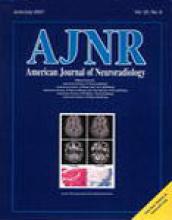Abstract
BACKGROUND AND PURPOSE: Dural AVF is a vascular anomaly that rarely occurs in children and is best treated by endovascular embolization. We report our experience using various endovascular embolization techniques in the treatment of dural AVF in a pediatric population.
METHODS: Seven children with angiographically proven dural AVF were treated with endovascular embolization using microcoils, N-butylcyanoacrylate, detachable balloons, and/or silk suture. All imaging studies, embolization procedures, and patient charts were retrospectively reviewed.
RESULTS: Seven children had been treated for dural AVF at our institution since 1987. Three newborns presented with congestive heart failure. Four older children (10 months–10 years) presented with signs referable to venous hypertension, including seizures, hydrocephalus, and proptosis. Embolization approaches included transarterial, transvenous, and direct puncture after neurosurgical exposure of a dural sinus. The number of embolizations ranged from 1 to 13 sessions per patient. All patients experienced symptomatic improvement after each embolization session. The three newborns showed marked improvement in cardiac function that allowed discharge to home. Clinical follow-up ranged from 3 weeks to 9 years (mean, 4.1 years). Two children with partially embolized dural AVF died, and one was lost to follow-up. Four children are alive after complete embolization of their dural AVF; two are developmentally normal, and two have mild developmental delay.
CONCLUSION: Endovascular embolotherapy is the current treatment of choice for dural AVF. Embolization therapy may be life saving in the setting of cardiac failure and curative in cases of small or simple fistulae. Multiple, complex dural AVF are usually not curable, and treatment is aimed at symptomatic relief. Treatment strategies focus on the location and/or complexity of the fistula, the patient's clinical status, and the neurologic prognosis.
- Copyright © American Society of Neuroradiology












